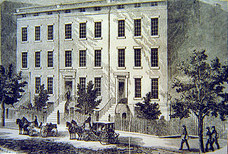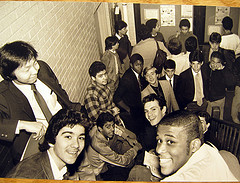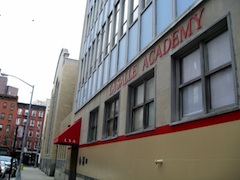La Salle Academy had its first beginnings in 1848, when four De La Salle Christian Brothers arrived in New York from France and established Saint Vincent’s School on Canal Street. St. Vincent’s relocated to Second Street in 1856, and in 1887 changed its name to La Salle Academy. In 1936, the Academy erected the large five-story school building that stands today.

Brother Virgil and His Class, 1872
The 1800s

First Site of School Canal Street, 1848
In 1848, Bishop John Hughes invited the Brothers of the Christian Schools in France to send Brothers to New York. Four Brothers arrived in the Lower East Side on July 26, 1848, and wasted little time in opening their first school for 90 boys in a church basement at 26 Canal Street.

44 Second Street, 1856
In 1856, the physical shift from Canal Street to Second Street occurred. The number of Brothers had grown from 4 to 26 at that point.Together they purchased a lot on Second Street formerly inhabited by American novelist Washington Irving. They would soon build a five-story building for the sum of $8,000.

La Salle Academy Class, 1880
In 1886, a young man by the name of Patrick Hayes graduated from La Salle, and in 1887 Patrick was followed by George Mundelein. Both of these men would later become Cardinals of the Church. In 1896, the New York Board of Regents granted La Salle Academy a school charter.
The 1900s

Interscholastic Basketball Team, 1909
The Lower East Side continued its rapid growth and changing population with a steady stream of immigrants seeking opportunity in the New World. The student population totaled 98 by 1906 and many students received academic Regents diplomas from New York State. However, by 1916 there were only 12 academic diplomas awarded, and the decision was made to admit students to commercial courses only.

City Champions, Business Class, 1920
By 1925, enrollment guidelines had changed and the Academy enrolled 300 boys. Enrollment continued to bloom and reached 700 in 1937 during the height of the Depression. The face of the Academy changed after World War II had ended and enrollment boomed. The ethnic composition of both the Lower East Side and the student body was also changing. However, despite the rapid changing of New York City and the nation, the educational mission of the Christian Brothers never lost focus. In order to celebrate 100 years of academic excellence and an enrollment of 900 students, a dinner gala was held at the Old Metropolitan Opera House in 1948. La Salle would soon reach its highest registration in history, approximately 950 students.

Student Body, 1932
Moskowitz and Lupowitz Restaurant, on the corner of 2nd Street and 2nd Avenue, was purchased in 1966 and until 2008 had served as the school annex, providing additional classrooms and office space.

Changing Times at La Salle, 1960
In the early 1970s, La Salle ushered in the computer age for the secondary schools of the Archdiocese of New York with the La Salle Academy Computer Project. Although primitive by today’s standards, the ability to call in to La Salle Academy’s mainframe and “timeshare” was a revolutionary step in technological access. The decline of the number of Christian Brothers that began in the late 60’s led to the incorporation of many lay teachers into the La Salle Academy educational community. Their diversity of personal and academic talents and backgrounds has enriched the educational experience of the students. The contributions of the lay teachers increased over the years to where they currently teach over 95% of the classes.

La Salle Students,1980
The heart of the Lasallian message, “Touching Hearts,” has become a way of life for many current and former faculty of La Salle. In 1997 La Salle Academy sought and received Middle States Accreditation for the first time in its history. This was soon followed in 2000 by receiving recognition as a National Blue Ribbon School of Excellence.













